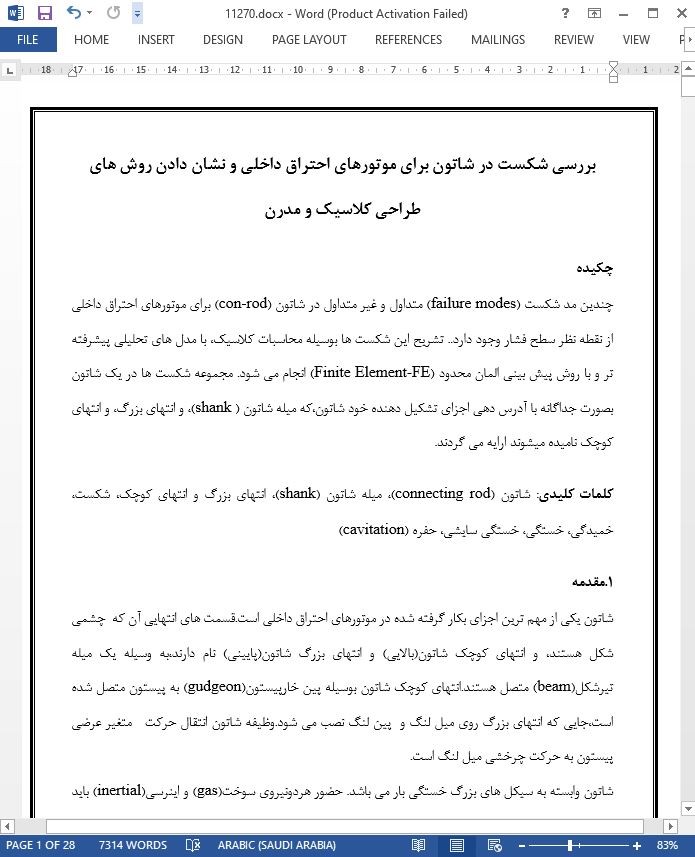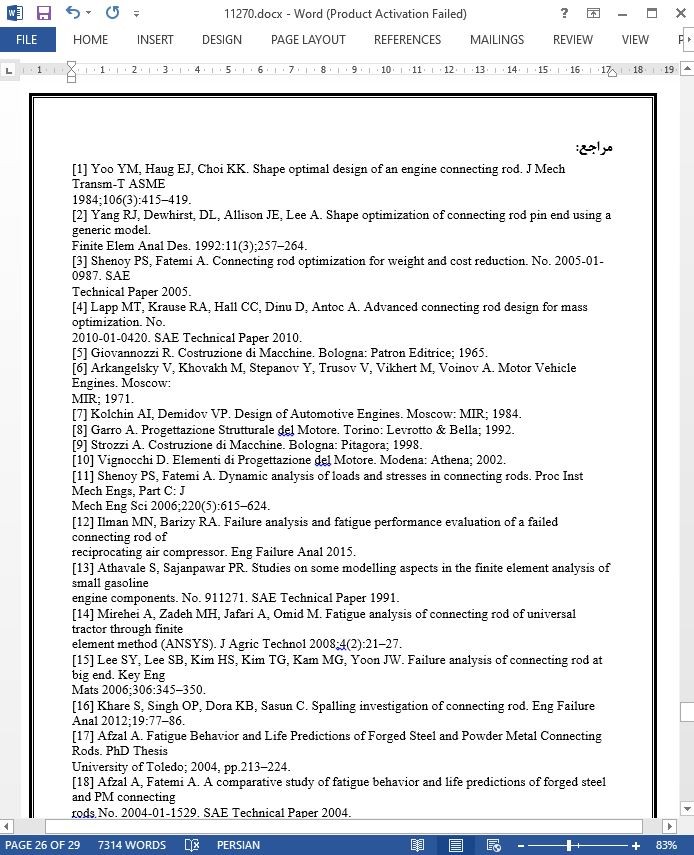
بررسی شکست در شاتون برای موتورهای احتراق داخلی
چکیده
چندین مد شکست (failure modes) متداول و غیر متداول در شاتون (con-rod) برای موتورهای احتراق داخلی از نقطه نظر سطح فشار وجود دارد.. تشریح این شکست ها بوسیله محاسبات کلاسیک، با مدل های تحلیلی پیشرفته تر و با روش پیش بینی المان محدود (Finite Element-FE) انجام می شود. مجموعه شکست ها در یک شاتون بصورت جداگانه با آدرس دهی اجزای تشکیل دهنده خود شاتون،که میله شاتون ( shank)، و انتهای بزرگ، و انتهای کوچک نامیده میشوند ارایه می گردند.
۱.مقدمه
شاتون یکی از مهم ترین اجزای بکار گرفته شده در موتورهای احتراق داخلی است.قسمت های انتهایی آن که چشمی شکل هستند، و انتهای کوچک شاتون(بالایی) و انتهای بزرگ شاتون(پایینی) نام دارند،به وسیله یک میله تیرشکل(beam) متصل هستند.انتهای کوچک شاتون بوسیله پین خارپیستون(gudgeon) به پیستون متصل شده است،جایی که انتهای بزرگ روی میل لنگ و پین لنگ نصب می شود.وظیفه شاتون انتقال حرکت متغیر عرضی پیستون به حرکت چرخشی میل لنگ است.
6.جمع بندی
شکست های متداول و غیر متداول در شاتون موتور احتراق داخلی از نقطه نظر سطح فشار توضیح داده شد.تفسیر این شکست ها با محاسبات کلاسیک با مدل های تحلیلی پیشرفته تر،و پیش بینی FE انجام شد.مکان حساس ترین بخش های شاتون به صورت خلاصه در شکل 1 نشان داده شد.
با رجوع به میله شاتون(shank)،ترک های خستگی که در ناحیه گذار بین انتهای کوچک و میله شاتون(shank) اتفاق می افتد را بررسی کردیم و تراکم های فشاری مرتبط با آن ها را با تحلیل های FE نشان دادیم.مثال هایی از خمش کناره ای،خمش جلو عقبی(front-rear buckling) و گشتاور نرم میله شاتون(shank)،را ارائه دادیم و دلایل احتمالی آن ها را هم واکاوی نمودیم.ترک خستگی نامتداولی که در 45º رخ داد را توجیه کردیم.ترک خستگی نامتداولی که کل شاتون را به دوقسمت تقسیم کرد را با جزییات تشریح کردیم،و فشار کششی که این ترک را موجب شده بود را به شکل هندسی ناحیه گذار میله شاتون چشمی شکل(eye-shank) نسبت دادیم.تاثیر شکل اشکال هندسی I شکل و H شکل را روی پیک فشار در نقطه تماس بین پین خارپیستون و انتهای کوچک،را با تحلیل FE نشان دادیم.
Abstract
Several typical and uncommon failure modes in con-rods for internal combustion engines are commented from the stress level viewpoint. The interpretation of the fractures is supported with traditional calculations, with more advanced analytical models, and with Finite Element (FE) predictions. The repertoire of failures in a con-rod is presented by separately addressing the parts composing the con-rod itself, namely the shank, and the small and big ends.
1. Introduction
The connecting rod is one of the most important components employed in internal combustion engines. Its extremities are shaped as eyes, named con-rod small end (upper) and con-rod big end (lower), connected by a beam-like shank. The small end of the connecting rod is joined to the piston by means of the gudgeon pin, whereas the big end is mounted on the crank-pin of the crankshaft. The function of the connecting rod is to translate the alternating transverse motion of the piston to the rotational motion of the crankshaft.
6. Conclusions
Both typical and uncommon failure modes in con-rods for internal combustion engines have been commented from the stress level viewpoint. The interpretation of the fractures has been supported with traditional calculations, with more advanced analytical models, and with FE predictions. The locations of the most critical con-rod sections examined in this paper are summarized in Fig. 1.
With reference to the con-rod shank, the fatigue cracks occurring at the transition zone between the small end and the shank have been considered, and the corresponding stress concentrations have been illustrated with a FE analysis. Examples of side buckling, of front-rear buckling, and of plastic torque of the con-rod shank, have been presented, and their possible causes have been explored. The occurrence of an unusual 45° fatigue crack in the con-rod shank has been justified. An uncommon fatigue crack, splitting the whole con-rod into two parts, has been detailed, and the tensile stresses promoting such crack have been attributed to a non traditional geometry of the eye-shank transition zone. The influence of the I-shaped and H-shaped shank geometries on the pressure peaks at the contact between the gudgeon pin and the small end bore has been illustrated with FE.
چکیده
۱. مقدمه
2. میله شاتون (shank)
3. انتهای کوچک شاتون
.3.2 اثر فضای خالی بین قطر داخلی انتهای کوچک و محیط پین
3.2 شل شدن بوش
3.3 آسیب فرسایش خستگی به انتهای کوچک
4. انتهای بزرگ شاتون
4.1 ناحیه اتصال بین میله شاتون(shank) و انتهای بزرگ
4.2 اتصال پیچی (bolt connection)
4.4 آسیب های ناشی از سایش خستگی در انتهای بزرگ
5.جنبه های تریبولوژیکی (Tribological)
6.جمع بندی
Abstract
1. Introduction
2. Con-rod shank
3. Con-rod small end
3.1 Effect of the initial clearance between small end bore and pin periphery
3.2 Bush loosening
3.3 Fretting fatigue damage in small ends
4. Con-rod big end
4.1 Connecting area between the shank and the big end
4.2 Bolt connection
4.3 Big end cap
4.4 Fretting fatigue damage in big ends
5. Tribological aspects
6. Conclusions
- اصل مقاله انگلیسی با فرمت ورد (word) با قابلیت ویرایش
- ترجمه فارسی مقاله با فرمت ورد (word) با قابلیت ویرایش، بدون آرم سایت ای ترجمه
- ترجمه فارسی مقاله با فرمت pdf، بدون آرم سایت ای ترجمه



